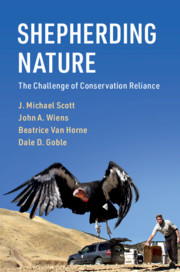Book contents
- Shepherding Nature
- Shepherding Nature
- Copyright page
- Contents
- Preface
- Acknowledgments
- 1 Extinction and the Challenge of Conservation Reliance
- 2 The Conservation Spectrum
- 3 The Genesis of Conservation Reliance and the Language of Conservation
- 4 What Are the Threats?
- 5 Emerging Threats in a Rapidly Changing World
- 6 The Role of Policy and Law
- 7 What’s in the Conservationist’s Toolbox: Species-Centered Approaches
- 8 Expanding the Conservationist’s Toolbox: Going Beyond Species
- 9 Conservation Reliance Is a Human Issue
- 10 Making Tough Decisions: Prioritizing Species for Conservation
- 11 Being a Good Shepherd
- Book part
- Essay Contributors
- References
- Index
2 - The Conservation Spectrum
Published online by Cambridge University Press: 28 February 2020
- Shepherding Nature
- Shepherding Nature
- Copyright page
- Contents
- Preface
- Acknowledgments
- 1 Extinction and the Challenge of Conservation Reliance
- 2 The Conservation Spectrum
- 3 The Genesis of Conservation Reliance and the Language of Conservation
- 4 What Are the Threats?
- 5 Emerging Threats in a Rapidly Changing World
- 6 The Role of Policy and Law
- 7 What’s in the Conservationist’s Toolbox: Species-Centered Approaches
- 8 Expanding the Conservationist’s Toolbox: Going Beyond Species
- 9 Conservation Reliance Is a Human Issue
- 10 Making Tough Decisions: Prioritizing Species for Conservation
- 11 Being a Good Shepherd
- Book part
- Essay Contributors
- References
- Index
Summary
Conservation reliance exists along a spectrum from species extinction to species recovery; from requiring intensive to minimal management. This chapter provides case studies of full or partial recovery and explores what made this possible using the Oregon chub, Aleutian cackling goose, southern white rhinoceros, black-capped vireo, and Robbins’ cinquefoil. Toward the other end of the spectrum, continued translocations or releases are required to maintain Oregon silverspot butterflies and Chatham Island black robins. Management is not always successful, however, as seen for Australian woylies. Some species, such as the Guam kingfisher, are extinct in the wild but maintained in zoos. Finally, there are lessons to be learned from species such as the po’ouli, dusky seaside sparrow, and Christmas Island pipistrelle, for which investments were too little or too late. Management of imperiled species is a societal investment and people’s attitudes play an important role in successful recovery. Participation by citizens and non-governmental organizations is particularly important when species are conservation reliant, as the long-term investment required can rarely be sustained otherwise.
Keywords
- Type
- Chapter
- Information
- Shepherding NatureThe Challenge of Conservation Reliance, pp. 25 - 54Publisher: Cambridge University PressPrint publication year: 2020

